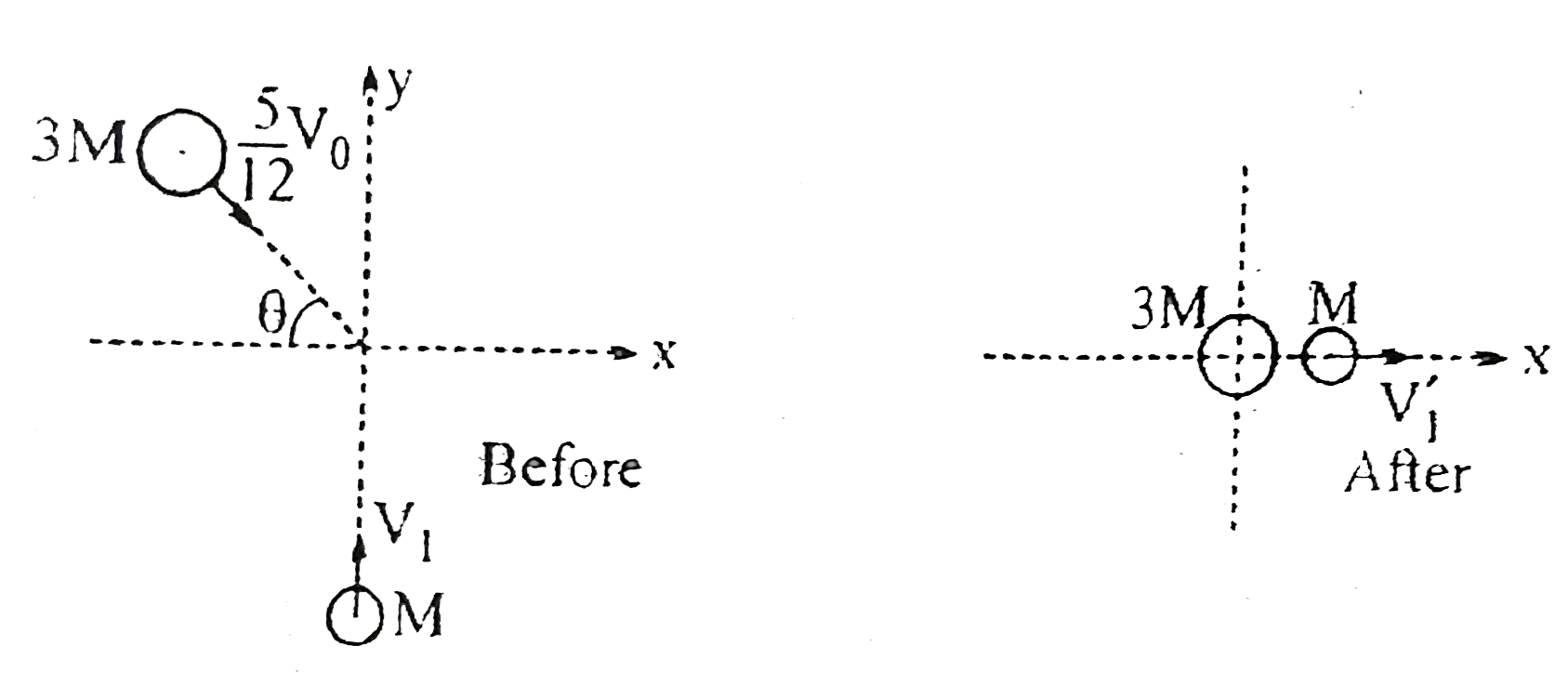Two masses M and 3M collide on a horizontal frictionless surface as shown. Before the collision the mass M has a velocity V1 in the y-direction. The mass 3M has a velocity (5/12)V0 making an angle thetha to the x-axis as shown. After the collision the mass 3M comes to rest and the mass M moves along the x-axis with the velocity V1 (Given sinthetha=3/5) Neglect gravity.

The speed V1 of mass M before collision is 34V0
The speed V1 of mass M before collision is V04
The speed V1 of mass M after collision is V02
The speed V1 of mass M after collision is V0
The correct Answer is:A, D
final momentum in y-axis is zero So MV1=(512V0sinθ)3M
V1=34V0 Along x-axis initial momentum = final momentum (512V0cosθ)3M=MV1
V1=V0
Topper's Solved these Questions
- MASTER PRACTICE PROBLEMBook:BANSALChapter:MASTER PRACTICE PROBLEMExercise:Subjective
Explore 107 Videos
- MASTER PRACTICE PROBLEMBook:BANSALChapter:MASTER PRACTICE PROBLEMExercise:Additional topic
Explore 70 Videos
- MASTER PRACTICE PROBLEMBook:BANSALChapter:MASTER PRACTICE PROBLEMExercise:Reasoning
Explore 75 Videos
- FLUID MECHANICSBook:BANSALChapter:FLUID MECHANICSExercise:PYQS AIEEE
Explore 10 Videos
- SEMICONDUCTORSBook:BANSALChapter:SEMICONDUCTORSExercise:CBSE Question
Explore 32 Videos
Similar Questions
In a given system of unit standard measurement of mass is 100 gm standard measurement of length is 200 cm and standard measurement of time is 5 sec 10 J energy in the given system of unit has value N, then value of N is
View SolutionThe manifestation of band structure in solids is due to
View SolutionStatement-1: The numerical value (n)of a physical quantity is inversely proportional to size of unit (u) being used to measure it.
Statement-2:The magnitude of physical quantity does not change by changing the units.
View SolutionA cylinder of height 20m is completely filled with water. The velocity of effux of water (∈ms−1) through a small hole on the side wall of the cylinder near its bottom is
View SolutionHow does the width of the depletion layer of a p-n junction diode change with decrease in reverse bias?
View SolutionA mass m moving horizontal (along the x-axis) with velocity v collides and stricks to mass of 3m moving vertically upward (along the y-axis) with velocity 2v . The final velocity of the combination is
View SolutionA particle of mass m moving with velocity v0 collides with sphere of same mass at rest , as shown. If the surface of contact is smooth and the collision is elastic, find the velocities of particle and sphere after the collision.

View SolutionA uniform cube of mass m and edge a moves on a horizontal surface along the positive x-axis, with initial velocity v0. Then
View SolutionTwo masses each with mass 0.10kg are moving with velocities 3m/s along x axis and 5m/s along y-axis respectively. After an elastic collision one of the mass moves with a velocity 4ˆi+4ˆj . The energy of other mass after collision is x10 then x is
View Solutionद्रव्यमान m का एक पिण्ड वेग u से चलता हुआ द्रव्यमान 3m के दूसरे स्थिर पिण्ड से प्रत्यास्थातः टकराता है | टक्कर के बाद दूसरे पिण्ड का वेग होगा :
View Solutionmভরের একটি বস্তু x- অক্ষ বরাবর v বেগে গতিশীল অবস্থায়, 2v বেগে y-অক্ষ বরাবর গতিশীল 3m ভরের একটি বস্তুর সঙ্গে সংঘর্ষ ঘটাল এবং বস্তু দুটি যুক্ত হয়ে গেল | সংযুক্ত ভরটির অন্তিম বেগ হল-
View SolutionTwo particles having masses m and 2m are travelling along x-axis on a smooth surface with velocities u_(1) and u_(2) , collide. If their velocities after collision are v_(1) and v_(2) , then the ratio of velocities of their centre of mass before ans impact is
View SolutionTwo particles having masses m and 2m are travelling along X-axis on a smooth surface with velocities u1andu2 collide. If their velocities after collision are v1andv2 then the ratio of velocities of their centre of mass before and after impact is
View SolutionA billiard ball of mass M , moving with velocity v1 collides with another ball of the same mass but at rest . If the collision is elastic , the angle of divergence after the collision is
View SolutionA particle of mass m moving with velocity u collides elastically with a particle of mass 3m at rest. After collision the heavier particle moves with velocity.
View Solution

